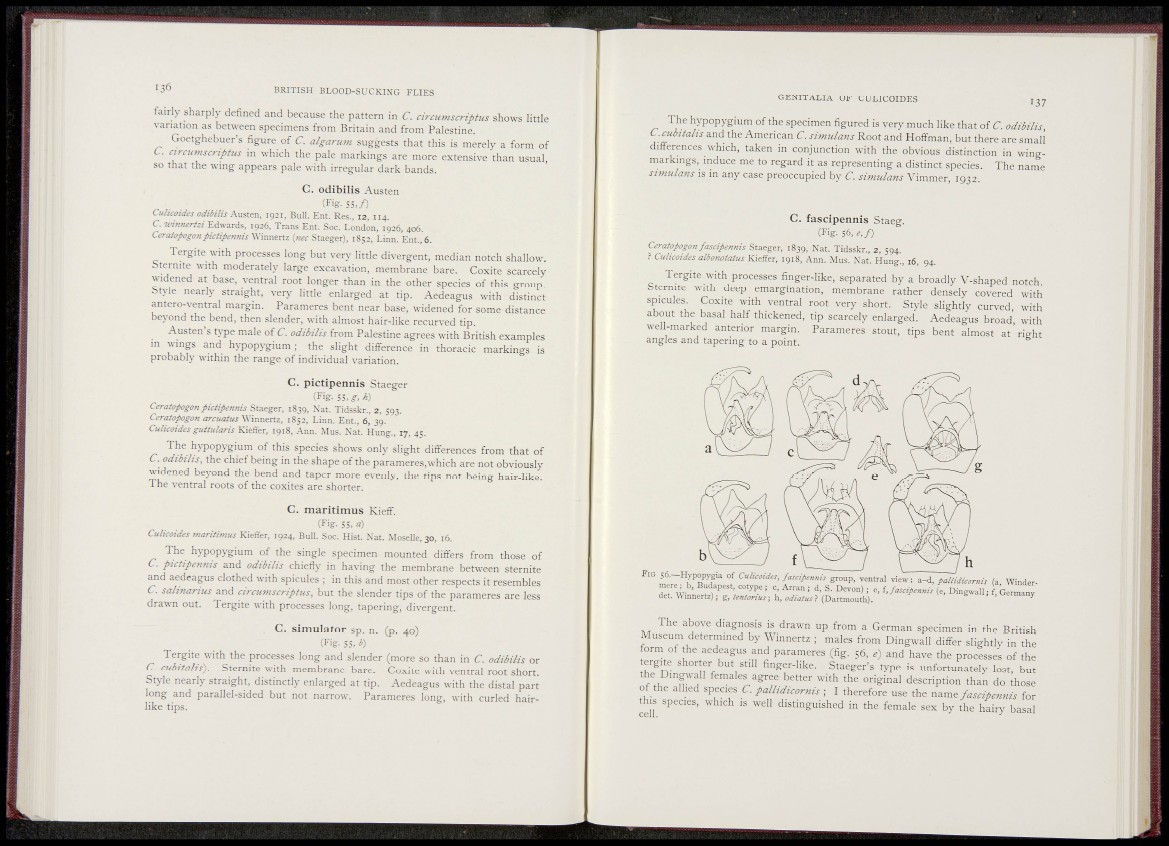
m isrwisassstjiffiP
136 B R I T I S H BLOOD-SUCKIXCx FLIES
fairly sharply defined and because the pattern in T. ciratmscnptus shows little
variation as between specmiens from Britain and from Palestine
Goetghebuer's figure of r . algannn suggests that this is merely a form of
6. nrcumsa-iptns ni which the pale markings are more extensive than usual,
so that the wing appears pale with irregular dark bands.
C. odibilis Austen
( F i g . 55. / )
O/Z/cij/iiVj Oi/Z^/Y/j Austen, 1921, Bull. Ent. Res., 12, 114.
r . icinnertzi Edwards, 1926, Trans Ent. Soc. London, 1926, 406.
Ceratopogonpictipennis Winnertz {nee Staeger), 1852, Linn. Ent., 6.
^ Tergite with processes long but very little divergent, median notch shallow,
bternite with moderately large exca^•ation, membrane bare. Coxite scarcely
widened at base, ventral root longer than in the other species of this c^roup
btyle nearly straight, very little enlarged at tip. Aedeagus with distinct
antero-ventral margin. Parameres bent near base, widened for some distance
beyond the bend, then slender, with almost hair-like recurved tip.
Austen's type male of C. odibilis from Palestine agrees with British examples
in wings and hypopygium ; the slight difference in thoracic markings is
probably within the range of individual variation.
C. pictipennis Staeger
(Fig. 55, h)
Ceratopog07jpictipenjiis Staeger, 1839, Xat. Tidsskr.. 2 . 593.
Ceraiopogon arciiatus \<\m\itTtz, 1852, Linn. Ent., 6, 39.'
CuKcoides guttidaris Kieffer, 1 9 1 8 , Ann. Mus. Xat. Hung., 17, 45.
The hypopygium of this species shows only slight differences from that of
C. odibilis, the chief being in the shape of the parameres,which are not obviously
widened beyond the bend and taper more evenly, the tips not being hair-like.
The ventral roots of the coxites are shorter.
C. maritimus Kieff.
(Fig. 55, a)
Culicoides mariti?7uis Kieffer, 1 9 2 4 , Bull. Soc. Hist. Xat. -Moselle, 3 0 , 16.
The hypopygium of the single specimen mounted differs from those of
C. pictipennis and odibilis chiefly in having the membrane between sternite
and aedeagus clothed with spicules ; in this and most other respects it resembles
C. salinarius and circm?iscriptus, but the slender tips of the parameres are less
drawn out. Tergite with processes long, tapering, divergent.
C. simulator sp. n. (p. 40)
(Fig. 55, b)
Tergite with the processes long and slender (more so than in C. odibilis or
C. cubitalis^. Sternite with membrane bare. Coxite with ventral root short
Style nearly straight, distinctly enlarged at tip. Aedeagus with the distal part
long and parallel-sided but not narrow. Parameres long, with curled hairlike
tips.
GENITALIA OF CULICOIDES 13 7
The hypopygium of the specimen figured is verv much like that of C. odibilis
L . cubitahs and the American C. simnlans Root and Hoffman, but there are small
differences which, taken in conjunction with the obvious distinction in wingmarkings,
induce me to regard it as representing a distinct species. The name
snmihms is m any case preoccupied by C. simidans \'immer, 1932.
C. fascipennis Staeg.
(Fig. 56,
Ceraiopogon fascipennis Staeger, 1839, Nat. Tidsskr., 2, 594.
? Culicoides albonofaius Kieffer, 1 9 1 8 , Ann. Mus. Nat. Hung., 16, 94.
^ Tergite with processes finger-like, separated by a broadly V-shaped notch
Sternite with deep emargination, membrane rather densely covered with
spicules Coxite with ventral root very short. Style slightly curved with
about the basal half thickened, tip scarcely enlarged. Aedeagus broad, with
well-marked anterior margin. Parameres stout, tips bent almost at right
angles and tapering to a point.
F I G 56.-Hypopreia of Culicoides, fascipennis group, ventral view: a-d, pallidicornis (a Windermere;
b, Budapest, cot>.pe ; c, Arran ; d, S. Devon) ; e, i, fascipc^ns fc Ding^vall; G ~
det. mnertz); g, tentorius; h, odiaU^s.? (Dartmouth). = ^. r. Germany
The above diagnosis is drawn up from a German specimen in the British
Museum determined by Winnertz ; males from Dingwall differ slightlv in the
form ot the aedeagus and parameres (fig. 56, and have the processes of the
ergite shorter but still finger-like. Staeger's type is unfortunately lost, but
the Dingwall females agree better with the origmal description than do those
of the alhed species C. pamdicornis ; I therefore use the ry^m^ fascipennis for
this species, which is well distinguished in the female sex bv the hairy basal
1 • M ^ t j i